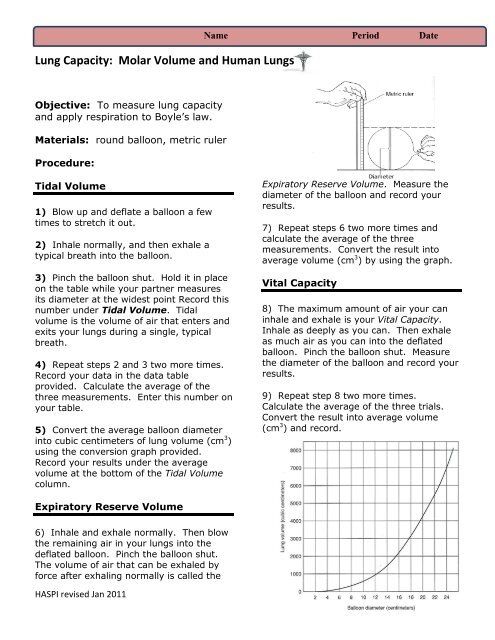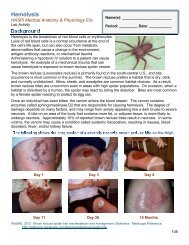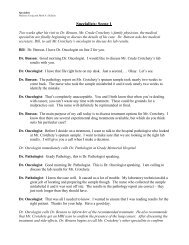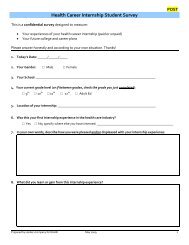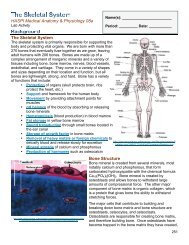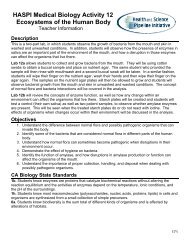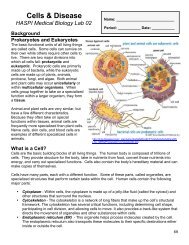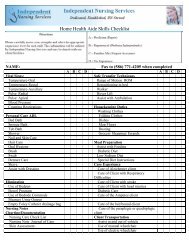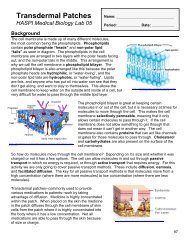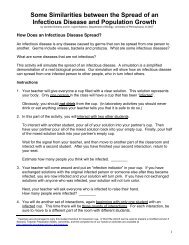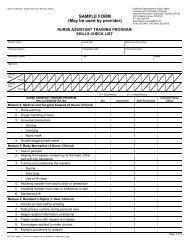04a Lung Capacity.pdf - haspi
04a Lung Capacity.pdf - haspi
04a Lung Capacity.pdf - haspi
- No tags were found...
Create successful ePaper yourself
Turn your PDF publications into a flip-book with our unique Google optimized e-Paper software.
<strong>Lung</strong> <strong>Capacity</strong>: Molar Volume and Human <strong>Lung</strong>sName Period DateObjective: To measure lung capacityand apply respiration to Boyle’s law.Materials: round balloon, metric rulerProcedure:Tidal Volume1) Blow up and deflate a balloon a fewtimes to stretch it out.2) Inhale normally, and then exhale atypical breath into the balloon.3) Pinch the balloon shut. Hold it in placeon the table while your partner measuresits diameter at the widest point Record thisnumber under Tidal Volume. Tidalvolume is the volume of air that enters andexits your lungs during a single, typicalbreath.4) Repeat steps 2 and 3 two more times.Record your data in the data tableprovided. Calculate the average of thethree measurements. Enter this number onyour table.5) Convert the average balloon diameterinto cubic centimeters of lung volume (cm 3 )using the conversion graph provided.Record your results under the averagevolume at the bottom of the Tidal Volumecolumn.Expiratory Reserve Volume. Measure thediameter of the balloon and record yourresults.7) Repeat steps 6 two more times andcalculate the average of the threemeasurements. Convert the result intoaverage volume (cm 3 ) by using the graph.Vital <strong>Capacity</strong>8) The maximum amount of air your caninhale and exhale is your Vital <strong>Capacity</strong>.Inhale as deeply as you can. Then exhaleas much air as you can into the deflatedballoon. Pinch the balloon shut. Measurethe diameter of the balloon and record yourresults.9) Repeat step 8 two more times.Calculate the average of the three trials.Convert the result into average volume(cm 3 ) and record.Expiratory Reserve Volume6) Inhale and exhale normally. Then blowthe remaining air in your lungs into thedeflated balloon. Pinch the balloon shut.The volume of air that can be exhaled byforce after exhaling normally is called theHASPI revised Jan 2011
<strong>Lung</strong> <strong>Capacity</strong>: Molar Volume and Human <strong>Lung</strong>sQuestions:Name Period DateQuestions1) What is the significance of calculating theaverage balloon diameter for tidal volume, vitalcapacity and estimated vital capacity?Answers2) Why did you have to convert the averageballoon diameter into lung volume (cm 3 )?3) For your data table above, you had to knowthat 1 mL = 1 cm 3 (1 cc). So, how many mL arein 1 L?4) How many liters of an ideal gas are containedin 1 mole of any ideal gas at STP (standardtemperature and pressure is 0 0 C and 1 atm)?5) Assume that the air from your lungs behavesas an ideal gas at STP. Calculate the number ofmoles of gas there are in your tidal volume,expiratory reserve volume, and vital capacityby using the data in your data table. Rememberthat molar volume is defined as 22.4 L per 1 mole.Tidal VolumeExpiratory ReserveVolumeVital <strong>Capacity</strong>6) Explain how Boyle’s law applies to respirationduring inhalation and exhalation7) In what situation would it be important toknow a person’s lung capacity?8) What 2 things could affect a person’s lungcapacity?HASPI revised Jan 2011


